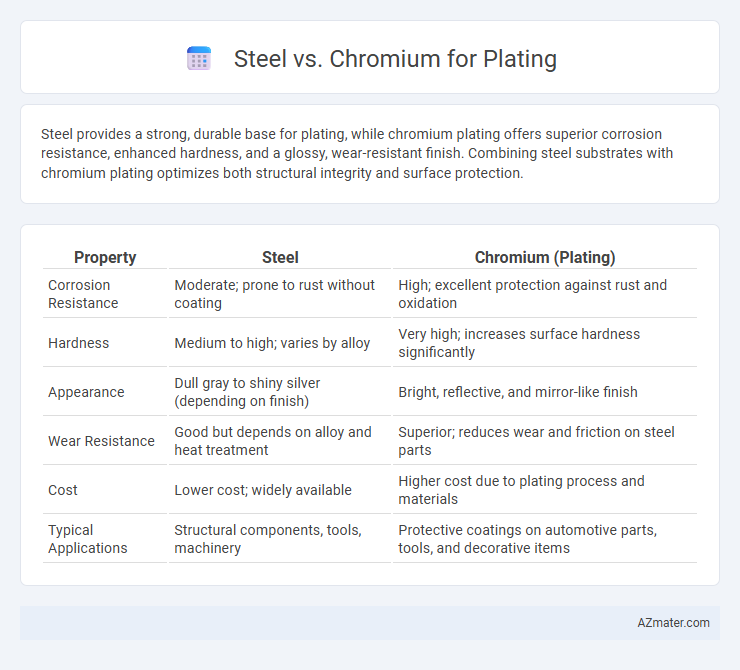Steel provides a strong, durable base for plating, while chromium plating offers superior corrosion resistance, enhanced hardness, and a glossy, wear-resistant finish. Combining steel substrates with chromium plating optimizes both structural integrity and surface protection.
Table of Comparison
| Property | Steel | Chromium (Plating) |
|---|---|---|
| Corrosion Resistance | Moderate; prone to rust without coating | High; excellent protection against rust and oxidation |
| Hardness | Medium to high; varies by alloy | Very high; increases surface hardness significantly |
| Appearance | Dull gray to shiny silver (depending on finish) | Bright, reflective, and mirror-like finish |
| Wear Resistance | Good but depends on alloy and heat treatment | Superior; reduces wear and friction on steel parts |
| Cost | Lower cost; widely available | Higher cost due to plating process and materials |
| Typical Applications | Structural components, tools, machinery | Protective coatings on automotive parts, tools, and decorative items |
Introduction to Steel and Chromium Plating
Steel, an alloy primarily composed of iron and carbon, offers excellent strength and durability, making it a popular base material for various applications. Chromium plating involves electroplating a thin layer of chromium onto steel surfaces to enhance corrosion resistance, hardness, and aesthetic appeal. This combination significantly improves the steel's lifespan and performance in harsh environments.
Physical Properties Comparison
Steel offers high tensile strength and excellent impact resistance, making it suitable for structural applications, while chromium plating enhances surface hardness and corrosion resistance. Chromium has a melting point of 1,907degC and provides a reflective, wear-resistant finish, whereas steel varies between 1,370degC and 1,540degC depending on the alloy composition. The combination of steel's robust mechanical properties with chromium's protective coating results in improved durability and aesthetic appeal.
Corrosion Resistance: Steel vs Chromium
Chromium plating significantly enhances the corrosion resistance of steel by forming a stable, chromium oxide layer that prevents rust and environmental damage. Steel alone is prone to oxidation and corrosion when exposed to moisture and air, leading to rust and structural degradation over time. Chromium's superior corrosion resistance makes it ideal for protecting steel components in harsh environments and extending the lifespan of metal products.
Durability and Longevity
Steel offers strong structural durability but is prone to corrosion over time without protective coatings, while chromium plating significantly enhances steel's resistance to rust, scratches, and wear. Chromium's hardness and corrosion-resistant properties ensure a longer lifespan for plated items, maintaining aesthetic appeal and functional integrity under harsh conditions. Steel substrates with chromium plating are commonly used in automotive, industrial, and household applications due to their combined strength and longevity.
Aesthetic Appeal and Surface Finish
Chromium plating on steel offers a superior aesthetic appeal due to its bright, mirror-like finish and enhanced corrosion resistance, making it ideal for decorative and automotive applications. Steel alone can have various surface textures but typically lacks the luster and durability that chromium plating provides. The chromium layer also improves surface hardness, resulting in a more scratch-resistant and durable finish compared to bare steel.
Cost Efficiency and Budget Considerations
Steel offers superior cost efficiency for plating applications due to its lower base material price and widespread availability, making it ideal for budget-conscious projects. Chromium plating on steel enhances corrosion resistance and aesthetic appeal, but increases overall costs due to expensive chromium material and complex plating processes. Selecting steel with a thin chromium layer can balance budget constraints while providing durable, attractive finishes in industrial and automotive applications.
Environmental Impact and Sustainability
Steel plating offers robust durability but involves higher CO2 emissions during extraction and processing, making it less sustainable compared to chromium. Chromium plating provides superior corrosion resistance with a thinner coating, reducing material use, yet its electroplating process involves toxic hexavalent chromium compounds, posing significant environmental and health hazards. Advanced methods like trivalent chromium plating and recycling initiatives improve chromium's sustainability profile, while steel's recyclability and long service life contribute positively to environmental impact assessments.
Common Applications in Industry
Steel plating offers exceptional strength and corrosion resistance, making it ideal for heavy machinery, automotive components, and construction tools. Chromium plating enhances surface hardness, wear resistance, and aesthetic appeal, frequently used in decorative finishes, aerospace parts, and industrial valves. Both materials serve critical roles in manufacturing processes requiring durability and precision.
Maintenance and Care Requirements
Steel plating requires regular maintenance to prevent rust and corrosion, especially if exposed to moisture or harsh environments, demanding frequent cleaning and application of protective coatings. Chromium plating offers superior corrosion resistance and requires less frequent upkeep, making it ideal for environments prone to oxidation. Both materials benefit from routine inspection, but chromium's durability reduces overall maintenance time and costs significantly.
Choosing the Right Plating Material
Selecting between steel and chromium for plating hinges on the required durability and corrosion resistance; chromium plating provides superior hardness and a reflective finish ideal for decorative and protective purposes. Steel substrates offer structural strength but require thorough surface preparation to prevent rust when plated, making them suitable for heavy-duty applications. Opting for chromium on steel combines the mechanical toughness of steel with chromium's ability to resist wear, oxidation, and tarnishing, extending the lifespan of plated components.

Infographic: Steel vs Chromium for Plating
 azmater.com
azmater.com